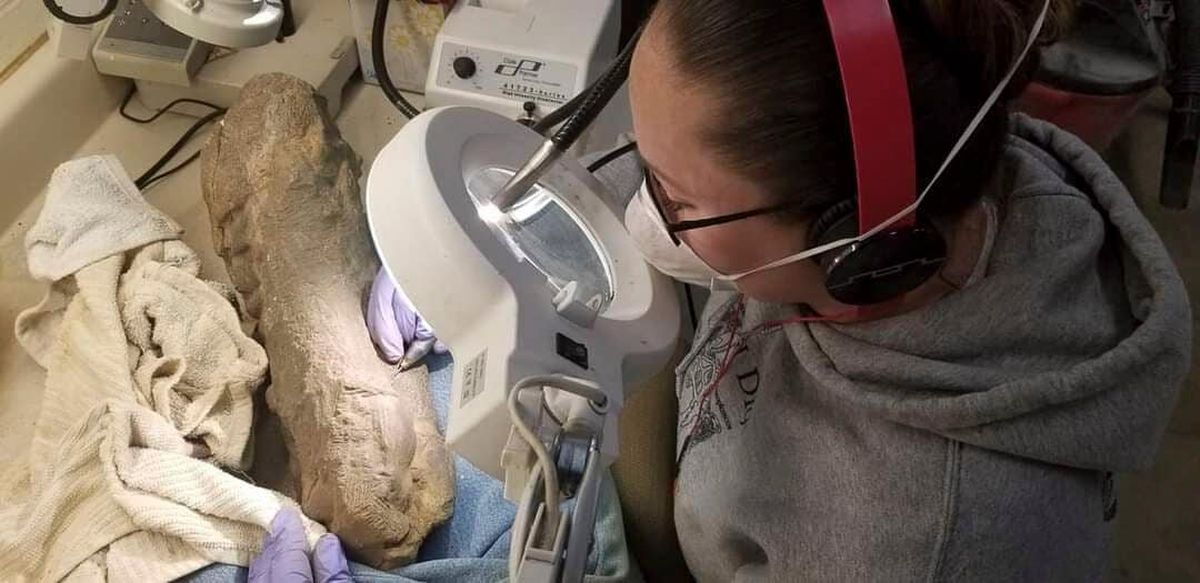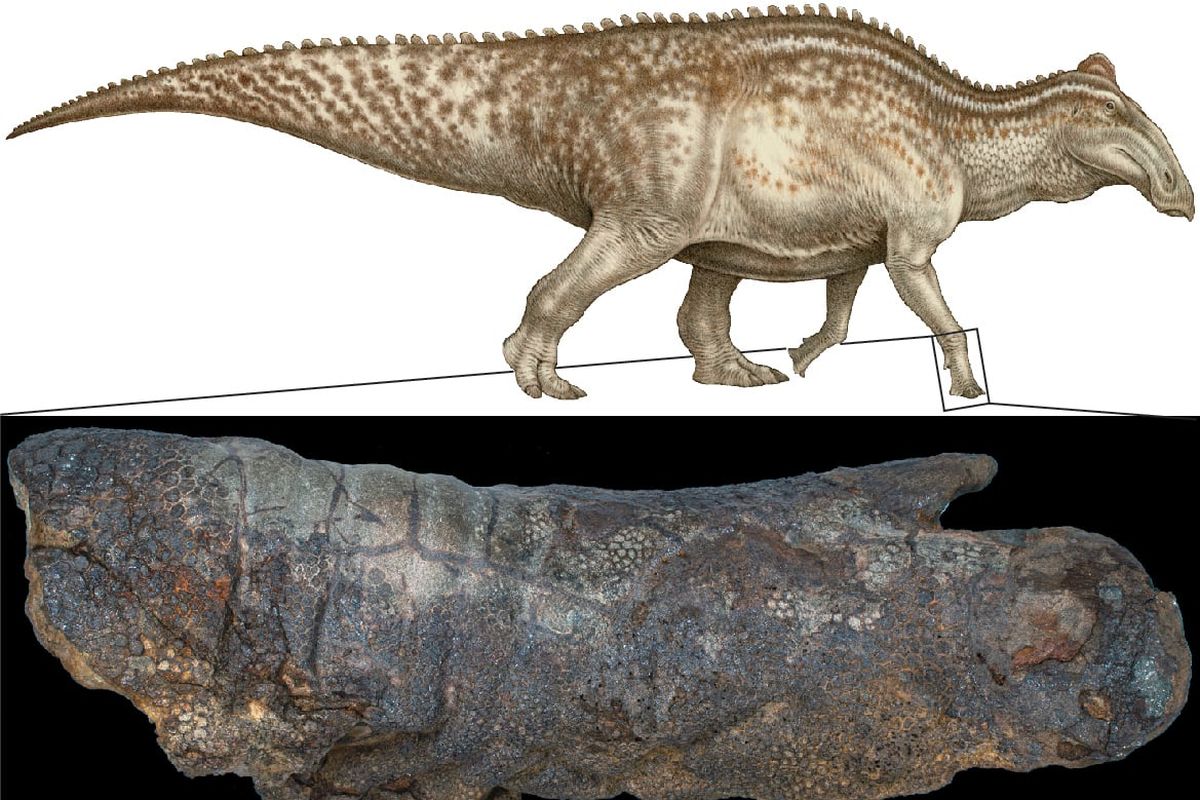‘Dino Mummy’ Reveals There May Be More Skin in the Fossil Game
In an undated handout image, Mindy Householder, a co-author of a study and a preparator at the State Historical Society of North Dakota, working on a section of fossil. Study of a hadrosaur named Dakota found a new explanation for how dinosaurs could be mummified with their skin preserved through the eons. (Drumheller et al., PLoS One, 2022 via The New York Times) -- NO SALES; FOR EDITORIAL USE ONLY WITH NYT STORY SCI MUMMIFIED DINOSAUR BY JEANNE TIMMONS FOR NOV. 7, 2022. ALL OTHER USE PROHIBITED. -- (DRUMHELLER ET ALL. PLOS ONE 2022)
Dakota the “dino mummy” has fascinated paleontologists and the public since part of the fossil was first untombed in North Dakota with some of its skin preserved.
Scientists are not finished making discoveries about Dakota, a duck-billed dinosaur, and they recently unlocked a well-preserved foot, a forelimb and more of its tail from the stone encasing the fossil. While more work needs to be done to fully expose this 66- to 67-million-year-old mummy, those parts of its anatomy alone are already challenging some paleontological theories.
A paper published recently in the journal PLOS ONE focuses on those recently exposed body parts, and offers new insight into how fossil mummies like Dakota might have survived. The new research even suggests there may be far more mummified skin out there to find in the fossil record and study than previously believed, if only paleontologists look in the right places.
Before this research, mummified dinosaurs were said to form in one of two ways: They were either buried rapidly after death, or they remained intact in an arid landscape long enough for the carcass to be preserved.
But further studies into the sediments surrounding the fossil suggest that Dakota lived not in a dry, arid place, but in a humid, wet environment. Its body lay close to a water source in its final moments. Bite marks recently identified on its bone and skin also indicate significant scavenging on this animal from a variety of carrion feeders, including ancestors of modern crocodiles and perhaps carnivorous dinosaurs like young T. rex or Dakotaraptors. If this dinosaur died near water and was scavenged by predators, why didn’t its soft skin rot away?
A new answer to this question started with Stephanie Drumheller, a paleontologist and an expert in bite marks at the University of Tennessee, Knoxville. CT scans showed the preserved skin was deflated, rather than compressed by sedimentary stone pressed down on it.
This was difficult to explain until Drumheller came to a realization: She had seen something like this in other preserved remains. But not dinosaur fossils. Rather, in human and mammalian bodies that were used in forensic anthropological research.
Human and mammalian remains can in some situations remain preserved in a wet environment for months. When these remains last it is because small scavengers burrow into the body, opening a pathway for liquids and gases to exit, and the skin eventually dries out and is preserved.
“This is weird and unexpected if you’ve only read the paleontological literature dealing with mummies,” Drumheller said. “But it’s really in line with the forensic anthropological literature.”
Incomplete scavenging, the team asserts, can actually help preserve an animal, even a dinosaur. Large predators may take chunks out of the animal, but they’re after the more nutritious muscle and internal organs. The gouges they make in pursuit of that meal also allow gases and liquids to escape the body. What remains on the landscape is a body of skin and bones that then slowly desiccates and deflates, eventually preserved for the eons.
The idea that “some degree of scavenging might favor the mummification of skin” is “an exciting discovery,” said Fion Waisum Ma, a vertebrate paleontologist at the Smithsonian National Museum of Natural History who was not involved in the research. “This study is comprehensive,” she said, “and gives us a new perspective on how soft tissue preservation may have occurred in dinosaurs and more generally in land vertebrates.”
Anecdotally, the team heard a number of stories from colleagues finding more patches of fossilized skin in the field than they expected, particularly when excavating hadrosaurs. Finding such fossils seemed to contradict the conventional wisdom behind dinosaur mummification, but until now, the scientific literature didn’t offer any other explanation for what researchers were observing.
Clint Boyd, a co-author of the study and a paleontologist at the North Dakota Geologic Survey, said he hoped the study would prompt many of his colleagues to say: “Yeah, of course. That makes sense with what we’re seeing.”
For the past three years, removing more of Dakota’s fossils from stone has been the work of Mindy Householder, another co-author of the study and a preparator at the State Historical Society of North Dakota. Her early work as a fossil preparator didn’t even include the possibility of fossil skin. Locating the bone within and removing it from the stone in which it was preserved, she said, was the focus of her training, and such methods may result in preserved skin being lost. It wasn’t until working on Dakota that this began to change.
The evidence she and her colleagues discovered, she said, may mean that “skin is more common than we thought it was.” And this, she added, “definitely should change” how fossils are treated.
Skin “could be there!” she said. “As a community, maybe we need to be more aware of that.”

